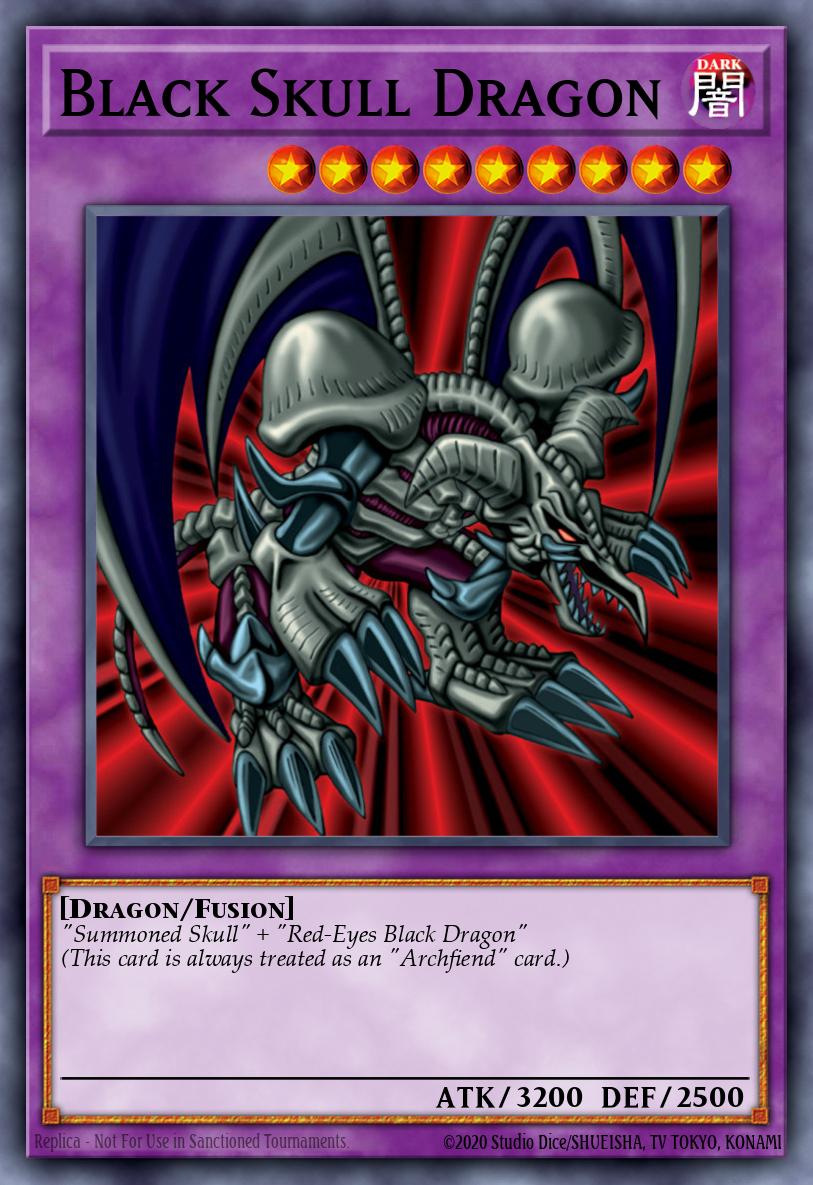 B. Skull Dragon
B. Skull DragonProduct Release History
Metal Raiders was first released in the TCG on June 26, 2002. This made Metal Raiders the first product release since the release of the Yugi and Kaiba Starter decks in late March of 2002. This booster set, much like Legend of Blue-Eyes White Dragon before it, was an amalgamation of two different OCG booster sets. This time, the sets were Revival of the Black Demon’s Dragon and Metal Raiders. The set would then go on to receive a variety of additional printings, receiving all of the same additional releases that Legend of Blue-Eyes had. The set received additional Unlimited print runs in both the 2002 and 2003 Collector’s Tins as well as a printing in the UK version of the 2004 Collector’s Tins. Metal Raiders would receive yet another Unlimited printing in 2004’s Master Collection. This was the first Worldwide English release of the set, and as such changed the set code to have an EN before the card’s set number. It also gave an errata to all Magic Cards to change them to Spell Cards, as was the standard by the time of the set’s release in late 2004. The next printing the set would receive was a further English Unlimited printing in the 2005 set Forbidden Legacy. The final print run the set would receive was in the 2010 Legendary Collection. This was yet another print run in Unlimited but was notable for excluding the EN before the set code in the North American and Latin American releases of the set.
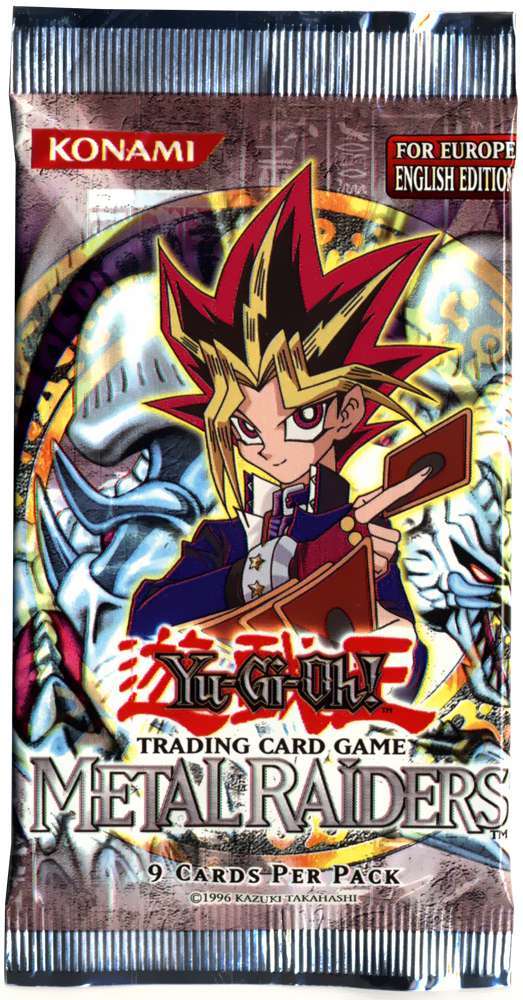
Set Breakdown
Metal Raiders consisted of 144 different cards, making it the largest non-reprint set ever released in the TCG. Of these cards, 100 were Common, 22 were Rare, 10 were Super Rare, 10 were Ultra Rare, and 2 were Secret Rare. Something interesting to note about the early sets was how each set was seemingly themed around a card type. While Legend of Blue-Eyes was themed around Normal Monsters, with those cards making up the bulk of the set, Metal Raiders was very focused on Effect Monsters. This is evident by the fact that there were only 2 Normal Monsters printed in the set in a rarity above Common.
Commons
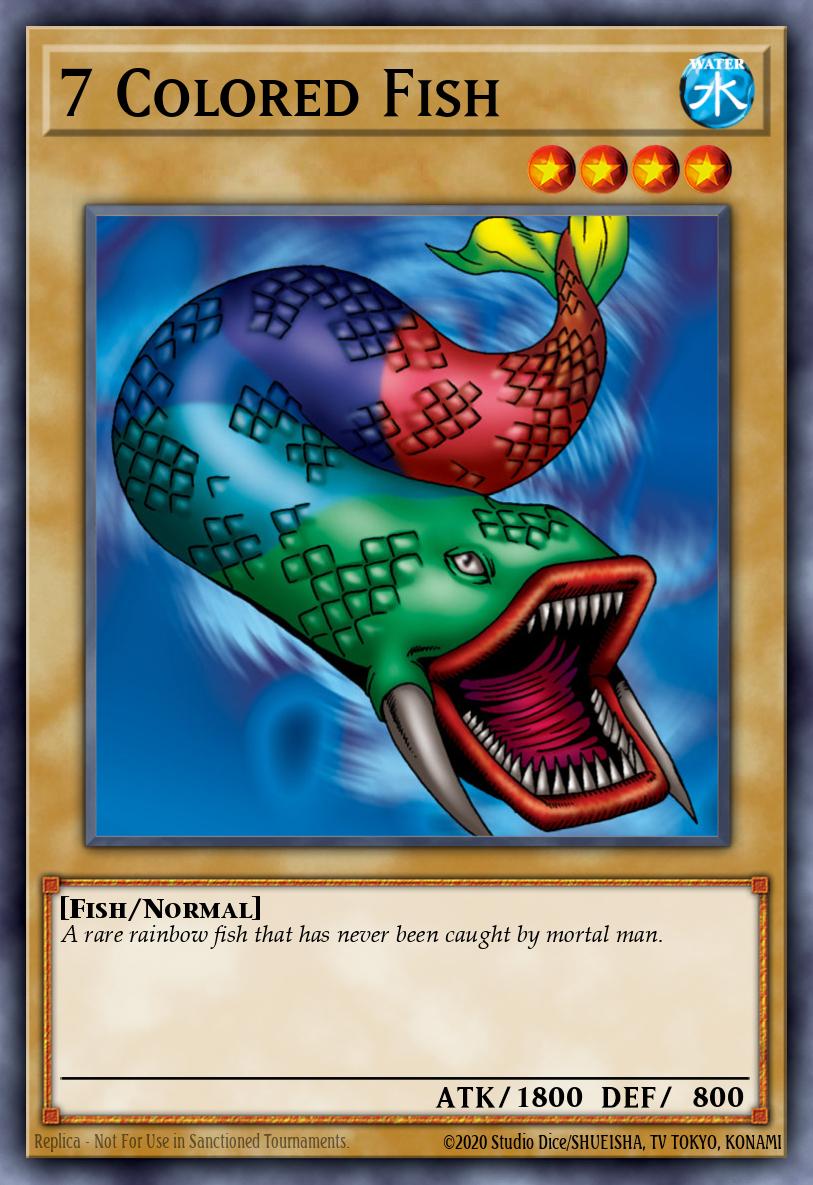 7 Colored Fish
7 Colored FishMuch like Legend of Blue-Eyes, a large number of the Commons in Metal Raiders were Normal Monsters. There were some notable Normal Monsters printed in the set, the most prominent of which is 7 Colored Fish. 7 Colored Fish was the second 1800 ATK level 4 monster ever printed, the first having been La Jinn the Mystic Genie of the Lamp in Starter Deck Kaiba. Because 1800 was the high water mark for non-Tribute monsters at the time, 7 Colored Fish became an instant staple in many decks. Most of the other Normal Monsters in the set were level 4 or lower monsters with relatively good ATK and DEF values considering the cardpool at the time. Unlike Legend of Blue-Eyes, which saw all of its Common Normal Monsters power creeped by the Starter Decks a short while after its release, Metal Raiders would not be followed by another set for several months. This meant that many of the 1500 and 1600 ATK Normal Monsters printed in the set would go on to see relatively widespread usage across a variety of casual Beatdown decks. The strongest of these Normal Monsters outside of 7 Colored Fish were Blue-Winged Crown and Ryu-Kishin Powered (first released in Starter Deck Kaiba) at 1600 ATK.
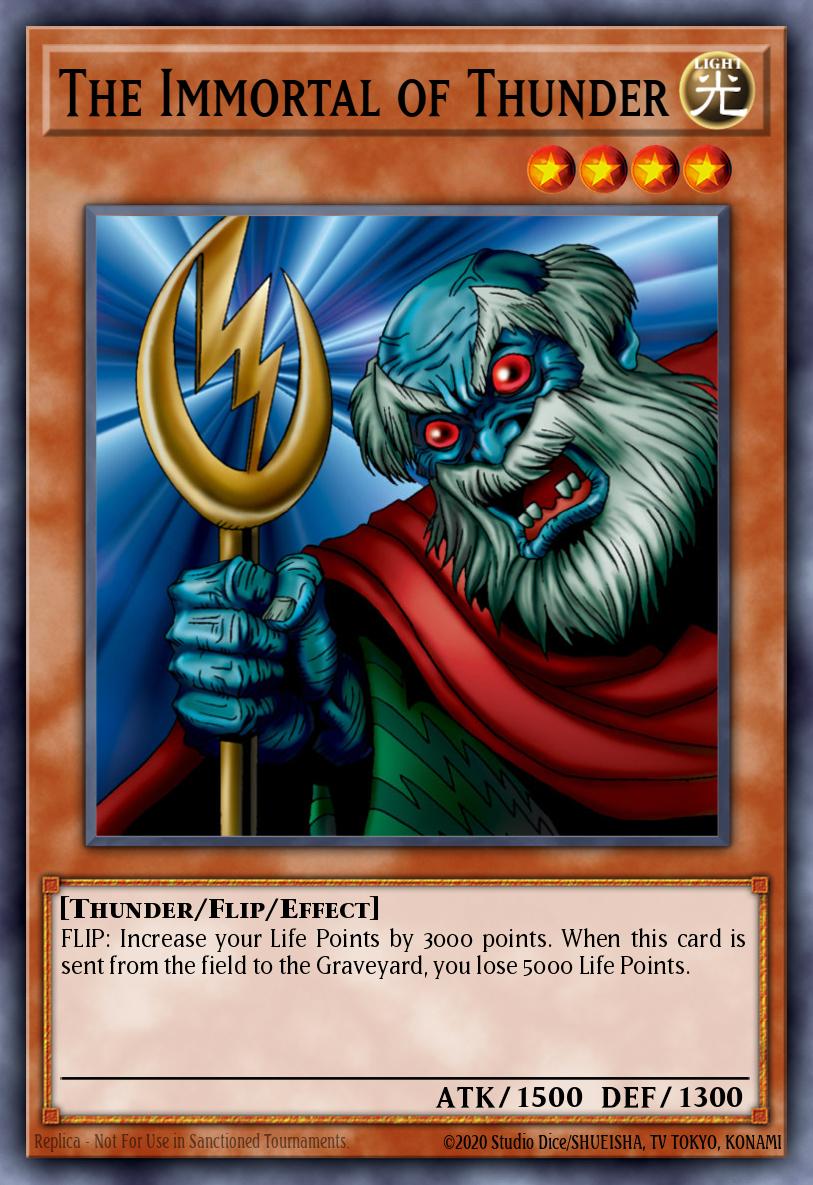 The Immortal of Thunder
The Immortal of ThunderOutside of the 49 Common Normal Monsters in the set, there were also a variety of Effect Monsters printed at Common. However, none of these monsters ever really saw much usage due to how detrimental or useless their effects were. Some notable examples include Yado Karu, Dragon Piper, and Steel Scorpion, all of which had effects that could only be useful in a very small subset of situations if at all. A few of the effect monsters that ended up seeing some play included Jirai Gumo, The Immortal of Thunder, and Big Eye. Jirai Gumo was notable for being level 4 with 2200 ATK, a higher value than even many Tribute monsters at the time. Despite the severe drawback that it carried, it did have some use in providing a high ATK wall that many monsters would have a hard time getting past. The Immortal of Thunder, with its massive life gain effect, ended up seeing some minor usage in Cyber-Stein decks in late 2006 due to the high life point cost associated with Cyber-Stein’s ability, justifying the risk of the card’s drawback. The fact that deck was focused around gaining a One Turn Kill made the drawback mostly irrelevant. Finally, Big Eye saw some casual play due to its ability to rearrange the top 5 cards of the deck at a time when searching the deck was minimal. This meant that the deck did not get shuffled often, making the ability to exercise some control over future draws useful. Despite this, Big Eye was definitely the least used of these three monsters. A final Common effect monster from this set of note was Bistro Butcher. It was one of the few level 4 1800 ATK monsters present in the game at the time, but carried the very severe drawback of allowing the opponent to draw 2 cards every time it inflicted battle damage. The main reason this card saw any play with such a severe drawback was the fact that the player base was still new to the game and tended to skew younger, meaning that things such as card advantage were often not considered when deck-building. The rest of the effect monsters all had relatively minor effects and saw only scvattered casual usage.
The final monsters printed at the Common rarity were several new non-Effect Fusion Monsters. Unlike the Fusion Monsters from Legend of Blue-Eyes, which had primarily been level 3 and 4, all of these new Fusion Monsters were level 5 or 6. This meant that they were stronger, but also that all of the level 6 Fusion Monsters would never see future usage as Instant Fusion targets. The five level 5 Fusion Monsters (Cyber-Saurus, Musician King, Kaminari Attack, Deepsea Shark, and Giltia the D. Knight) to this day still have potential usage as Instant Fusion targets. Out of these, the only one that has seen any kind of meta usage so far is Cyber-Saurus due to it being a level 5 Earth Instant Fusion target, but the others all have potential as Instant Fusion targets given the right future archetype. However, the level 6 Fusion Monsters would see some usage not too long after their release. This would come with the advent of Magical Scientist in the Magician’s Force booster set in late 2003. The card spawned a dedicated First Turn Kill deck that exploited Magical Scientist’s ability to Special Summon level 6 or lower Fusion Monsters. These monsters would then be tributed for the effect of Catapult Turtle or Cannon Soldier to inflict direct damage to the opponent. When this combo first came onto the scene, the monsters used to enable it were all of the strongest level 6 Common Fusion Monsters from Metal Raiders.
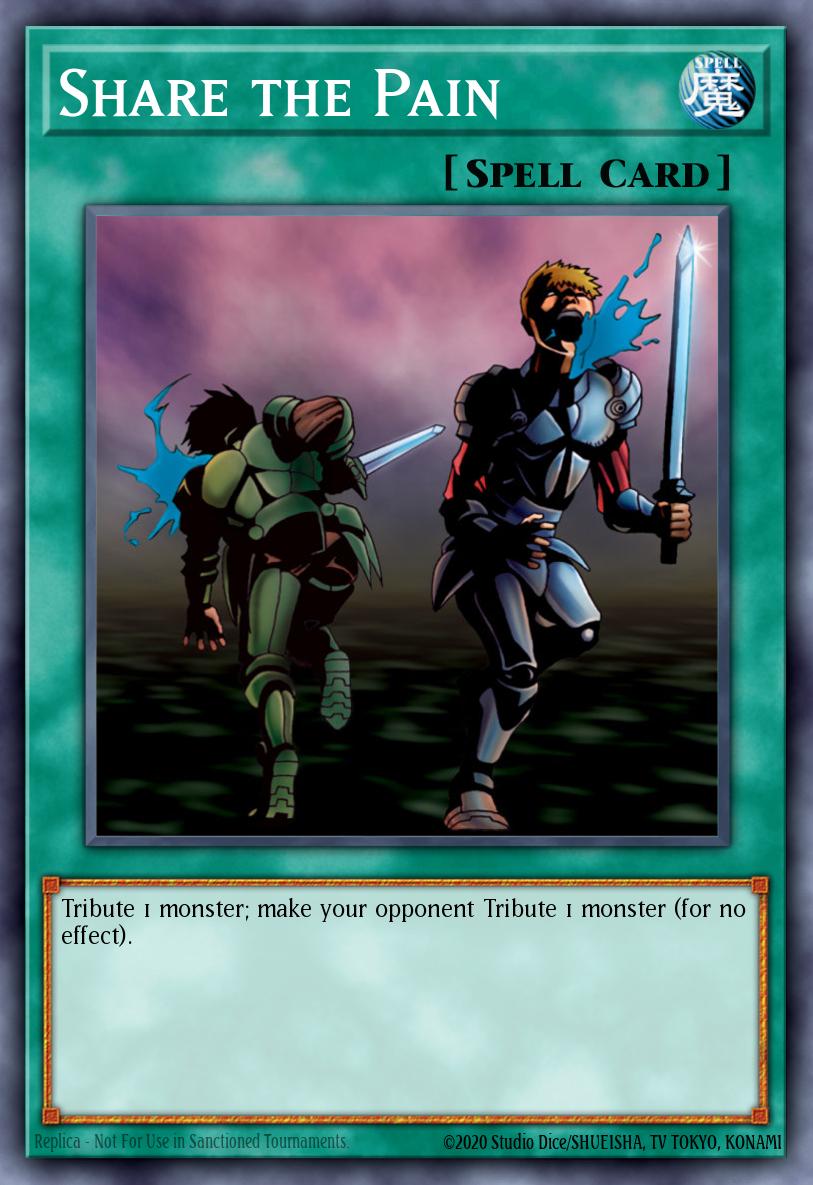 Share the Pain
Share the PainIn addition to the numerous monster released as Commons, Metal Raiders also included several new Spell cards as Commons. These are split relatively evenly between Normal Spell cards and Equip Spell cards. There were 5 different Normal Spells: Soul Release, The Cheerful Coffin, Tremendous Fire, Block Attack, and Share the Pain. The Cheerful Coffin was definitely the worst of these as its effect had almost no practical application at the time and served mostly as a detriment to the player using it. The other 4 Normal Spells, while not explicitly detrimental, only had relatively niche uses. Soul Release served as a good counter to Graveyard based strategies which, although not prominent at the time, would become more useful as the Graveyard became more and more of an integral part of the game. Soul Release would even see some use in side decks in more Graveyard based formats, although it was largely replaced by D.D. Crow in 2006. Tremendous Fire also saw use in burn decks due to it being the strongest burn card at the time with no setup required (Just Desserts could deal more damage but not against an empty field). Block Attack also saw some very minor usage as a tool to get past monsters with high ATK and low DEF, but the instances where this was useful were few and far between. Finally, Share the Pain was a largely underused card at the time due to its high cost for relatively little gain. It required a tribute to remove only one monster at a time where Summoning multiple monsters in a single turn was very uncommon. There were also very few monsters at the time with strong enough effects to merit using Share the Pain as removal over easier options such as Fissure or Tribute to the Doomed. Share the Pain would, however, see some usage much later on in the game. This was due to the prominence of a card called Apoqliphort Towers in mid-2015. This card was unaffected by the opponent’s card effects and had a very high ATK, making it very difficult to remove from the field. Share the Pain, however, states that both players have to choose one of their own monsters to tribute for its effect, meaning that it doesn’t count as the opponent’s card effect removing Apoqliphort Towers from the field.
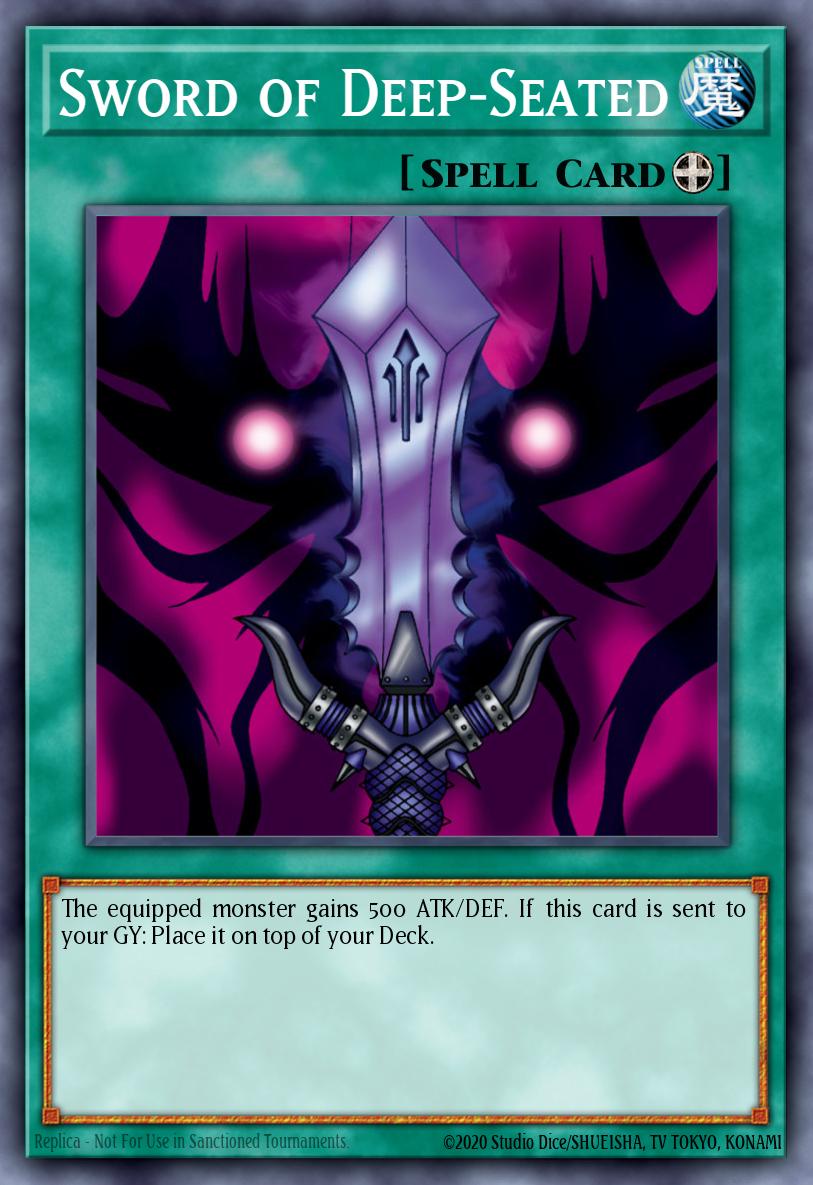 Sword of Deep-Seated
Sword of Deep-SeatedThe final 4 Spells are all Equip Spells. The first of these is Sword of the Deep-Seated. While this card is quite weak by modern standards, it holds the distinction of being one of the first generic ATK boosting Equip Spell released in the TCG. Before Sword of the Deep-Seated, all Equip Spells that boosted ATK required the monster that they were equipped to to have a specific Type or Attribute. Sword of the Deep-Seated also offered a slightly higher boost than these specific Equip Spells. The main drawback of the card was that it would return to the top of the deck when sent to the Graveyard. While this could be helpful in allowing re-use of the card, it also shut its controller out of drawing new cards. Despite this drawback, its accessibility caused the card to see some usage in more casual decks. The next Equip Spell is Ring of Magnetism. This card offered the ability to force an opponent to direct all their attacks at the equipped monster, but the card’s drawback was that it weakened the monster it was equipped to. For it to be useful, the equipped monster had to have either very high base ATK or be immune to destruction by battle. These were especially difficult criteria to meet at the time and the relatively weak benefit of redirecting attacks made the card never see much play.
The last two Common Equip Spells both have negative effects intended for use against an opponent’s monsters. The first of these is Paralyzing Potion which stops the equipped monster from attacking. While this effect was somewhat useful for stalling, the ease with which it could get bypassed by simply tributing the equipped monster or attacking with a separate monster prevented it from ever gaining much traction. The impotence of Paralyzing Potion was further solidified as more and more Spell and Trap removal was released in the following sets, making the card even easier to work around. The final Equip Spell is Germ Infection. Germ Infection causes a decrease in ATK over time, but suffers from much the same problems as Paralyzing Potion while also being much slower, preventing it from having a noticeable impact on the game.
The set also contained 12 different Short Print Commons. All of these Short Prints were monsters except for one Equip Spell, Stim-Pack. Stim-Pack was a particularly powerful equip at the time of its release as it conferred a 700 ATK bonus, making it the strongest available Equip Spell at the time. However, the drawback to the card was that it caused the equipped monster’s ATK to decrease by 200 every turn. Regardless of the drawback, this meant that the Spell was as powerful or more powerful than Sword of the Deep-Seated for 2 turns before becoming weaker. This caused Stim-Pack to see play amongst many decks at the time.
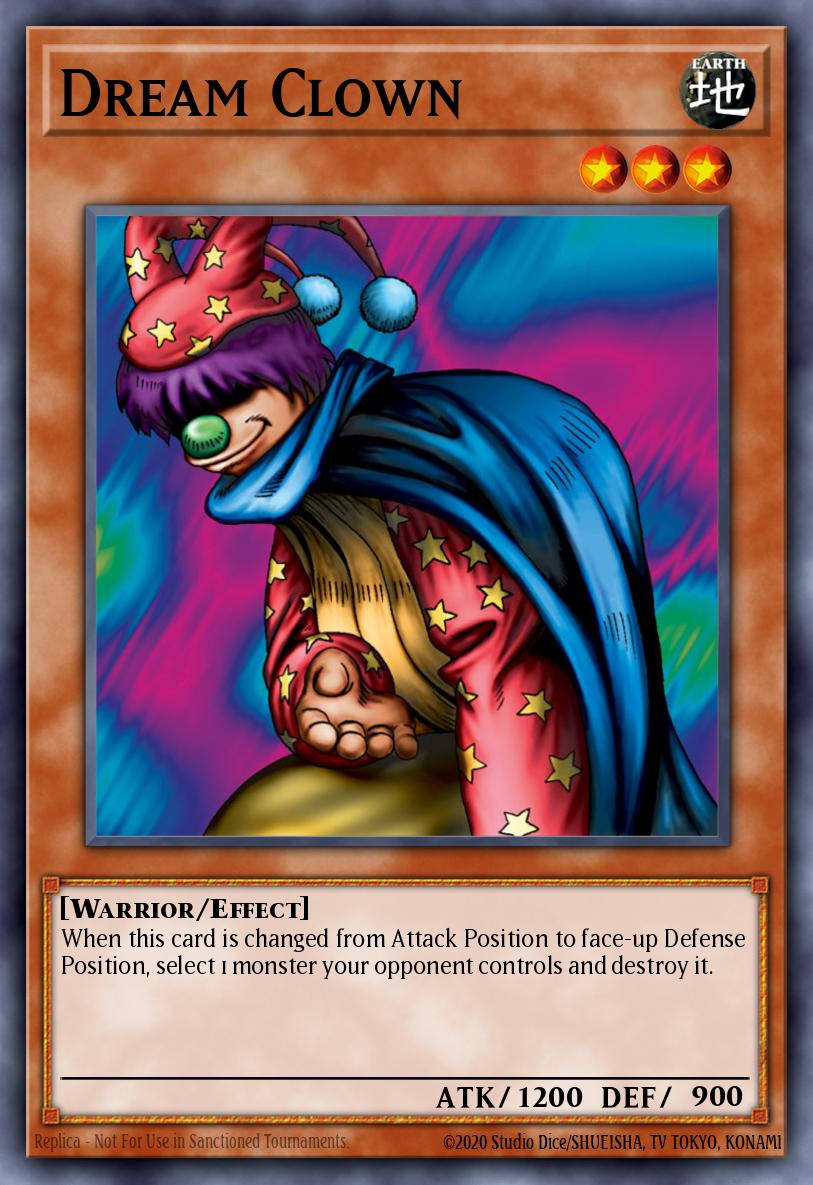 Dream Clown
Dream ClownThe other Short-Printed Commons were made up of a relatively good spread of Effect Monsters and two Normal Monsters. The first set of Effect Monsters were 6 monsters which all had very low ATK and had the ability to attack the opponent’s Life Points directly regardless of how many monsters they controlled. While none of these monsters would ever be particularly popular, they did have some general usefulness with the advent of more powerful ATK boosting Equip Spells in later booster sets. The next Effect Monster released as a Short Print is The Unhappy Maiden. Although it has weak stats, Unhappy Maiden would see usage in the early game due to its potent ability to stall the opponent by ending the Battle Phase upon being destroyed. This ability gave it some usefulness in Exodia and Burn decks early on, but later cards such as Messenger of Peace and Gravity Bind as well as monsters that can’t be destroyed by battle would largely supplant it. The next Short Print is Thunder Dragon. This card, although relatively useless on the surface as a level 5 monster with only 1900 ATK, was used as a tech choice during the Chaos Format. This was due to its ability to discard and search out additional copies of itself, all while being Light attribute. This made it perfect for both deck thinning, filling the Graveyard with Light monsters for Chaos summons, and giving excess cards to be used as discard fodder for Spells like Tribute to the Doomed and Graceful Charity.
The final two Short Print Commons are Dream Clown and Crass Clown. Both of these cards have effects when their Battle Position is changed. Although they never caught on as general use monsters, they would become the central monsters of a Rogue deck during the early years of the game: Clown Control. Clown Control focused on using cards that changed Battle Position such as Zero Gravity, Earthquake, and Stumbling to trigger Dream Clown and Crass Clown’s effects. This allowed the deck to easily destroy an opponent’s board while the Clowns’ lower levels let the deck to easily utilize Gravity Bind for additional stalling.
The last two Commons in the set are the 2 Super Short Prints. While there has never been any official confirmation by Konami that this rarity actually exists, many early sets are theorized to have been printed with two Super Short Print Commons each, meaning they are more than 3 times as rare as any given standard Common card. The two in Metal Raiders are Gazelle, the King of Mythical Beasts and Cocoon of Evolution. Neither of these cards had any real use or value outside of being cards used by characters in the anime.
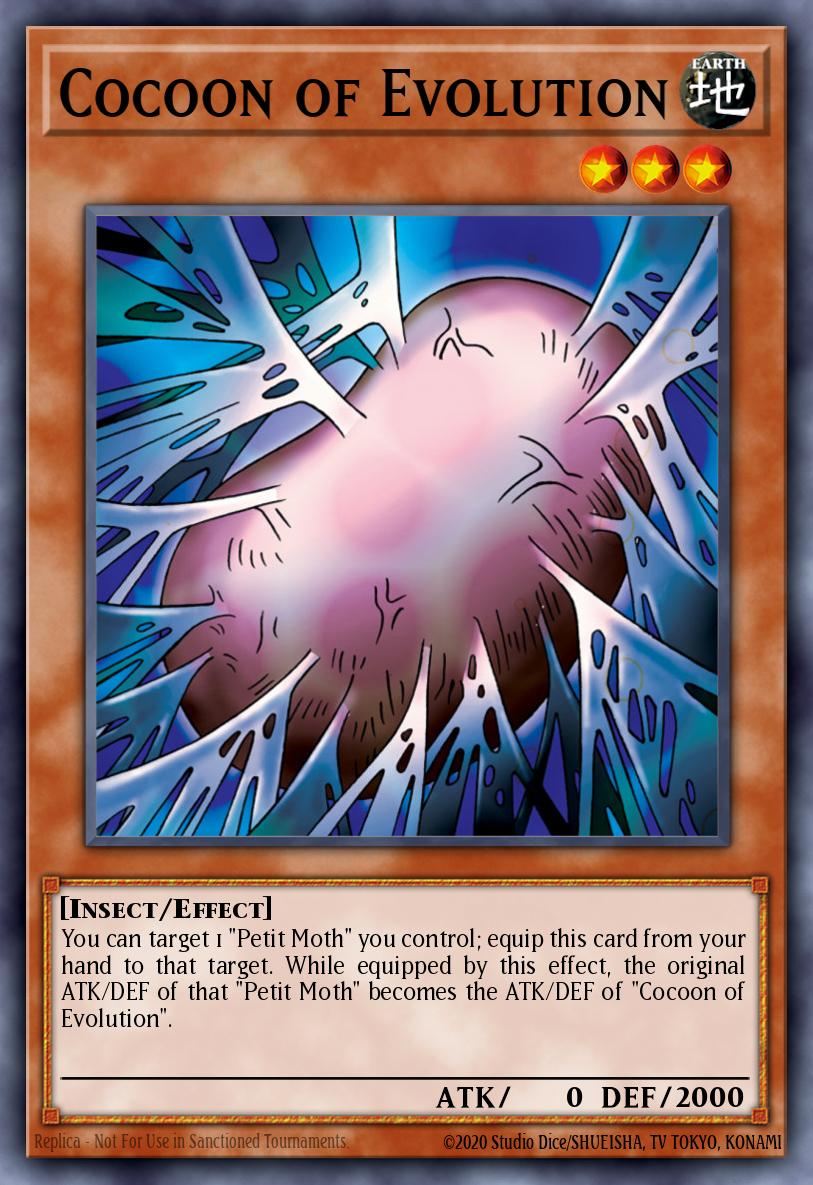 Cocoon of Evolution
Cocoon of EvolutionRares
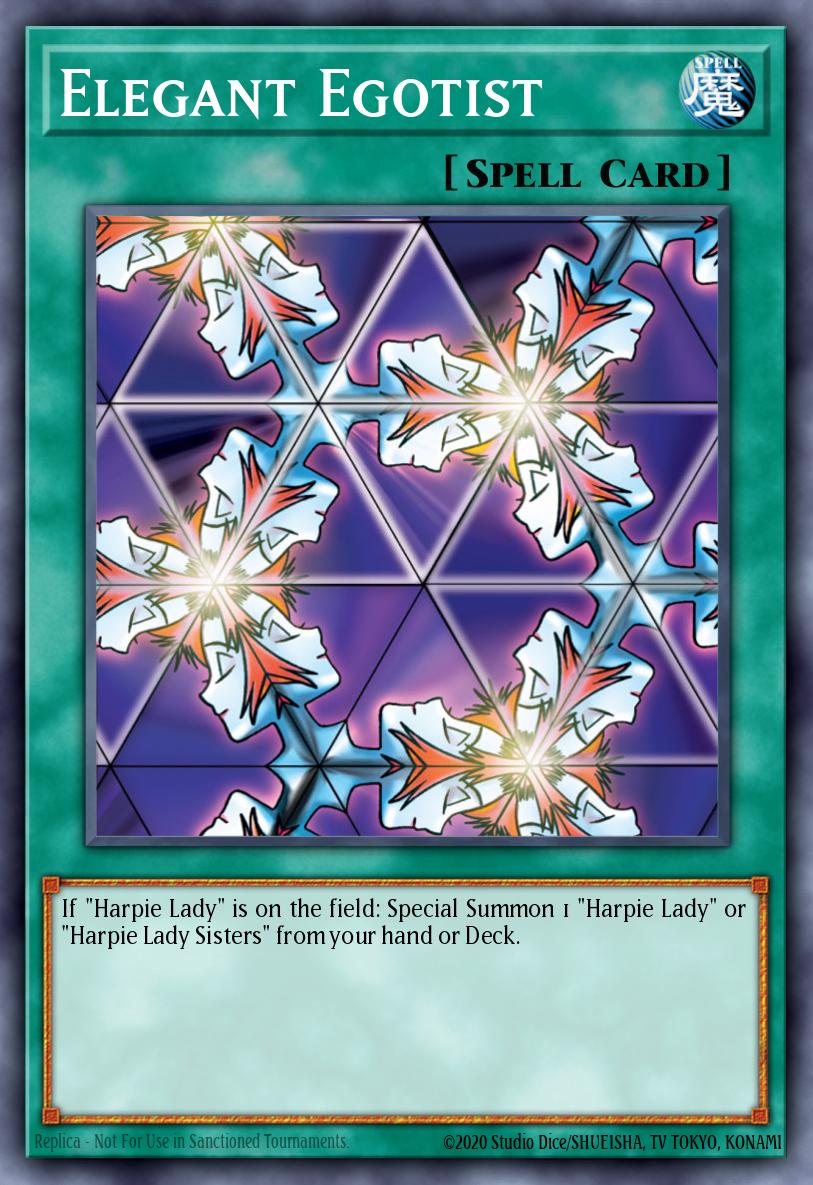 Elegant Egotist
Elegant EgotistMetal Raiders included 22 Rare cards with 2 Spells, 2 Traps, and 18 Monsters. The two Spells printed at Rare were Elegant Egotist and Sword & Shield. Sword & Shield, despite being a relatively prominent card in the anime, was too specific of an effect to ever see much play. Elegant Egotist was similarly weak at the time, only really being useful as a card from the anime. However, Elegant Egotist would see more usage much later on in the game as more and more Harpie Lady support cards were released. It allowed for easier summoning of Harpie Lady monsters to the field which would facilitate Xyz summons in the dedicated Harpie decks that entered the meta in 2014.
The first Rare Trap in the set was Robbin’ Goblin. This card, unlike many of the other low rarity cards in Metal Raiders, actually had a relatively useful effect. It allowed its controller to easily dismantle an opponent’s hand just by dealing damage. Because of this, Robbin’ Goblin did see limited play in some decks during 2002 and early 2003. While it would get outclassed later on by more accessible monsters with discard effects such as Don Zaloog and Spirit Reaper, Robbin’ Goblin still served as a precursor to the trend of Hand Control strategies that would dominate the 2003 TCG metagame. The other Rare Trap Card was Fake Trap. This card had the purpose of protecting a Trap Card from destruction, although it was at the cost of having to reveal the Trap Card that would’ve been destroyed to the opponent. Because of the specificity of its protection and requirement of revealing the protected Trap, Fake Trap never really caught on.
Although the Spells and Traps released as Rares in Metal Raiders held some interest, the really impactful Rares were the monsters. A very significant portion of the Rare monsters released in this set would see competitive play for at least the remainder of 2002, while some saw competitive play for years to come. The first pair of competitive Rare monsters are Mask of Darkness and Magician of Faith. Both of these were weak Flip Effect monsters that had the ability to recover a Trap and Spell card from the Graveyard respectively. While both would go on to see play, Magician of Faith would prove to be much more popular due to how much more powerful Spells were in the early game, with many of the strongest cards available at the time being Spells. Magician of Faith would become so prevalent that in 2005 it was Limited and a year later was Forbidden, staying at that status for many years.
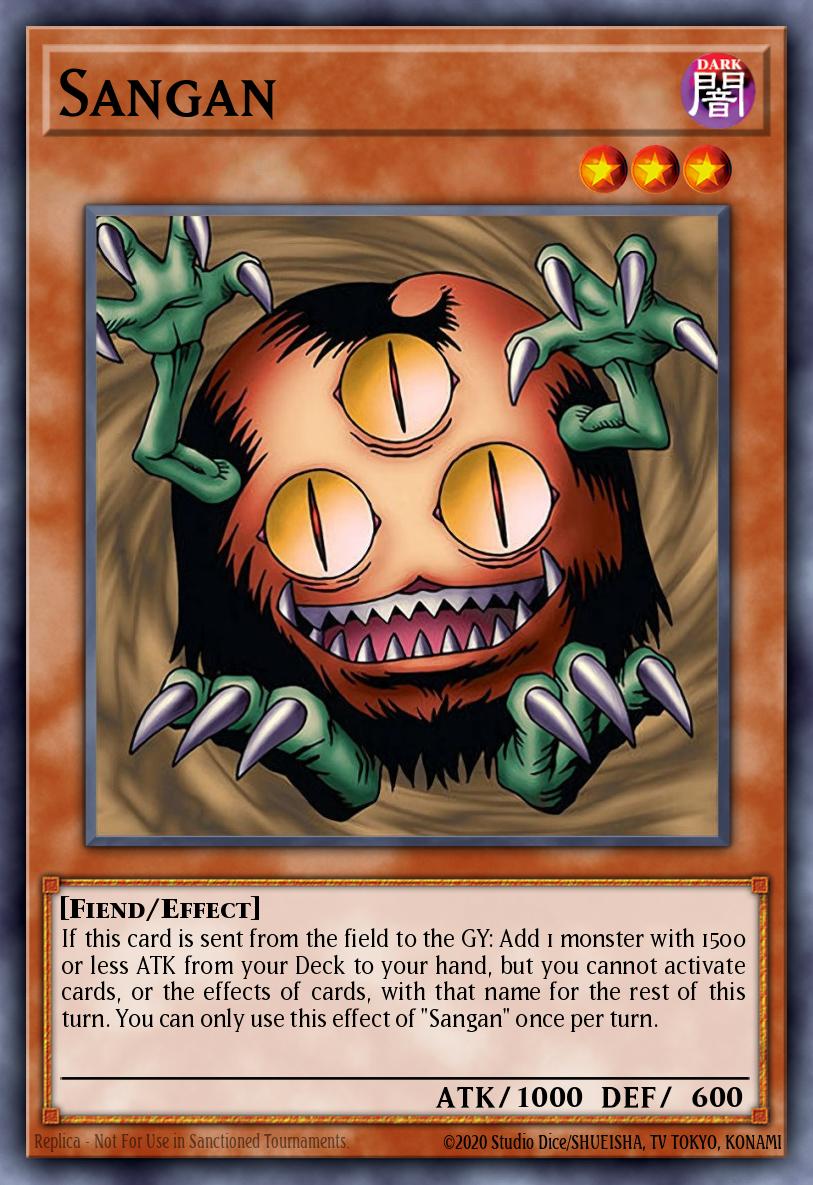 Sangan
SanganThe next impactful Rare monsters are Sangan and Witch of the Black Forest. These two monsters are arguably the most important cards released in the whole booster set. Both of them share an effect that allows the controlling player to search out another monster from the deck when they are sent from the field to the Graveyard. Sangan searches any monster with 1500 or less ATK and Witch of the Black Forest searches any monster with 1500 or less DEF. These effects are very notable for being the first ever search effects introduced into the TCG. Because of the extremely wide pool of cards that Sangan and Witch of the Black Forest were able to search, they were both immediate staples in almost every deck in the game. Because of this staple status, they would both be quickly Semi-Limited and then Limited, with Witch of the Black Forest falling onto one of the early Forbidden and Limited Lists as Forbidden. Sangan would manage to stay in the game for many more years, not becoming Forbidden until 2013. Something of note is that in the current game, both of these cards have received an errata to their text making it so that the monster they search cannot be used the turn it is searched in addition to adding a hard once per turn limit to both of their effects. Because of these errata, the value of the original cards in the metagame is relatively small now. Sangan does, however, still hold some usage because of the popularity of legacy formats where the pre-errata version is legal such as the famous Goat Format.
The final 4 Rare monsters that saw use were White Magical Hat, Dark Elf, Masked Sorcerer, and Cannon Soldier. While none of these cards ever experienced the longevity of use that Sangan and Magician of Faith did, they were still relatively popular upon their release. White Magical Hat was notable for being the first monster with a discard effect. It didn’t see much play initially because its low ATK made it difficult for the monster to actually deal damage and use its effect. However, once more powerful Equip Spells were released in the later sets of 2002, the card became more feasible to use. While it would be power creeped by stronger cards such as Don Zaloog and Spirit Reaper, White Magical Hat still had its time in the sun in early Hand Control based decks. Dark Elf saw even less use, being primarily used for its high ATK stat. Although it had a relatively severe drawback of costing Life Points whenever it attacked, its ability to get past an opponent’s 1800 ATK level 4 monsters allowed it gain some traction. The usage of Dark Elf would not last, however, as the release of more powerful Equip Spells and cards such as Goblin Attack Force would render its 2000 ATK obsolete.
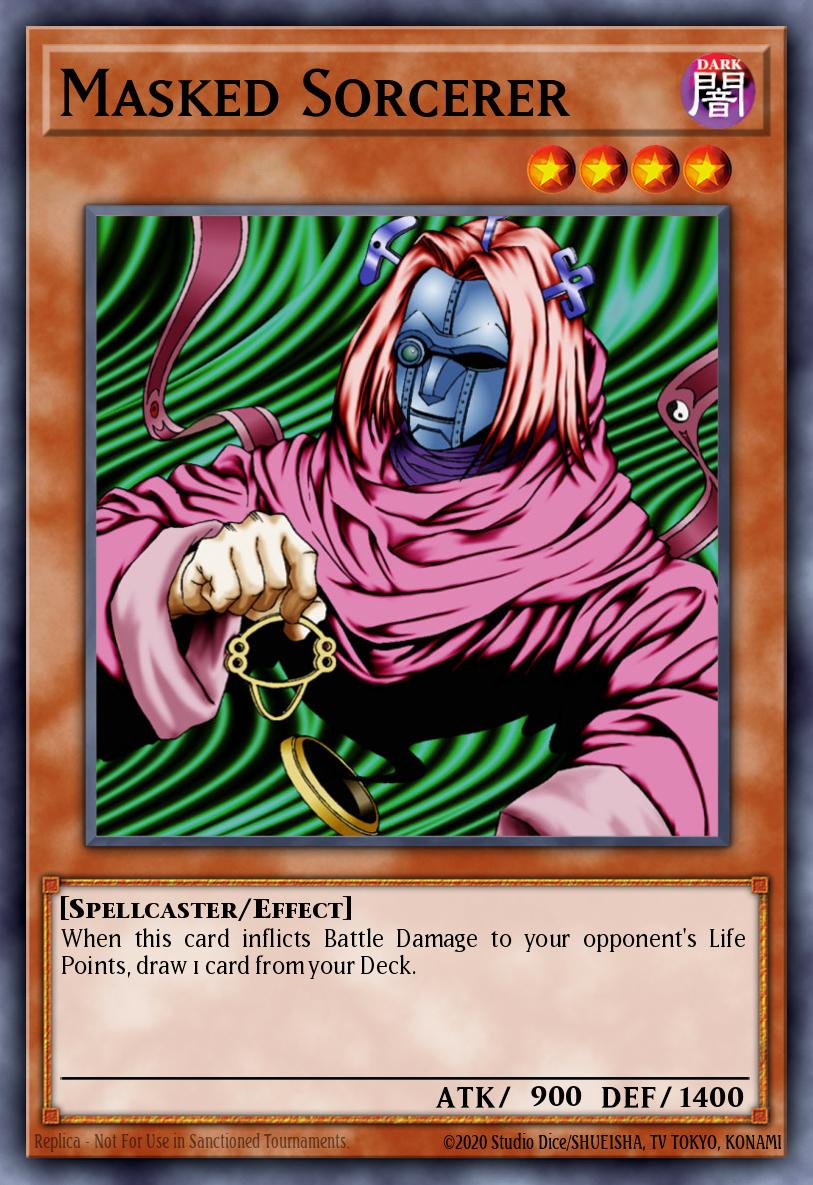 Masked Sorcerer
Masked SorcererThe next Rare monster that would see play was Masked Sorcerer. Although relatively weak, Masked Sorcerer’s effect allowed for the generation of card advantage, something that was difficult to find in monsters at the time. Because of this, Masked Sorcerer saw some play in various decks as a tech choice up through the 2004 Chaos Format. The card was especially valuable as a tech choice because its Dark attribute made it good fodder for a Chaos summon even after was destroyed. The final Rare monster in Metal Raiders that saw competitive usage was Cannon Soldier. Although not initially very popular, the card would find its niche in Magical Scientist decks, serving as a backup for when Catapult Turtle was inaccessible. Cannon Soldier also saw some usage in Cyber-Stein decks in late 2006 as it was both a Machine and inflicted burn damage, giving it synergy with the deck’s overall OTK based strategy and usage of Limiter Removal. However, the Forbidding of Cyber-Stein and Limiting of Limiter Removal would end up seeing Cannon Soldier fall out of use.
The next group of Rare monsters released in Metal Raiders was a set of 6 monsters, one for each attribute. They all share the effect of boosting monsters of their same attribute’s ATK by 500. While these monsters weren’t completely useless, their low ATK made them difficult to properly use as they would often be easily destroyed before they could have much of an effect.
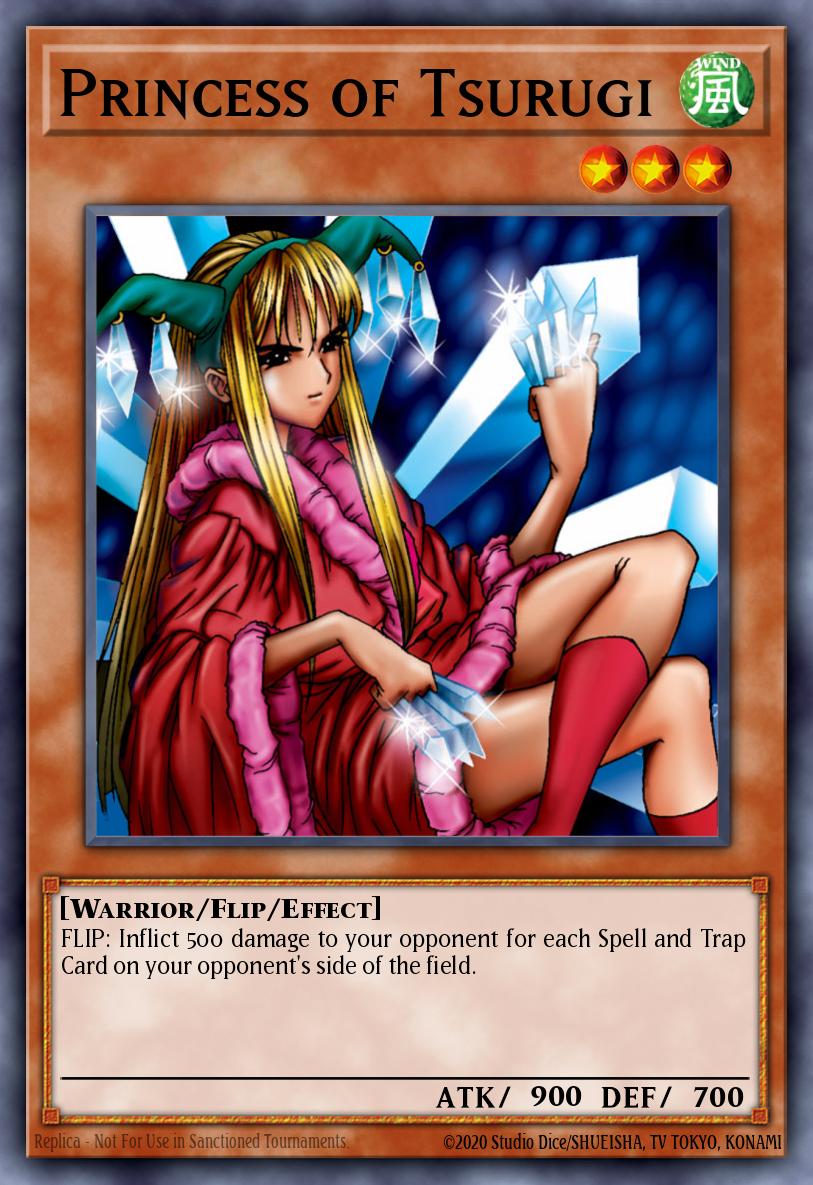 Princess of Tsurugi
Princess of TsurugiThe final 4 Rare monsters never saw much usage, falling into obscurity relatively soon after the set’s release. A partial exception to this is Princess of Tsurugi. Since it was one of the only burn cards in Yu-Gi-Oh! at the time, it became a staple in early 2002 burn decks. However, at this point burn decks were not very popular and by the time the strategy became more prevalent, cards such as Princess of Tsurugi were dropped in favor of monsters more dedicated towards stalling the opponent. This is because an increasing number of Spells and Traps that could inflict burn damage supplanted the slower effects of monsters that inflicted burn damage.
The next monster is Shadow Ghoul, a relatively weak tribute monster that required the Graveyard to be set-up to be useful. However, due to the low ATK boost it received for each individual monster in the Graveyard, it took far too much set-up to make the card stronger than most other powerful single tribute monsters, preventing it from ever seeing much use. Next is Muka Muka, a monster that similarly required a lot of set-up to be useful. However, unlike Shadow Ghoul, Muka Muka gained ATK based on hand size, a much more difficult to accrue resource. Because of this, Muka Muka required a relatively large number of cards in the hand to even be on par with the standard 1800 ATK level 4 monsters that dominated the landscape at the time. This made it a more unreliable choice than monsters with a fixed ATK. The final Rare monster released in Metal Raiders is Great Moth. The final step in the evolutionary ladder of Insect monsters used by Weevil Underwood in the anime, Great Moth’s summoning condition prevented it from ever being properly usable. Although it had slightly higher ATK than the 2500 ATK high water mark for single tribute monsters at the time, it required far too many turns of waiting in addition to forcing a player to run sub-optimal cards like Cocoon of Evolution and Petit Moth. Because of these factors, Great Moth would never serve as anything more than a collector’s card and a prime example of a card that is far too difficult to feasibly summon in a real game.
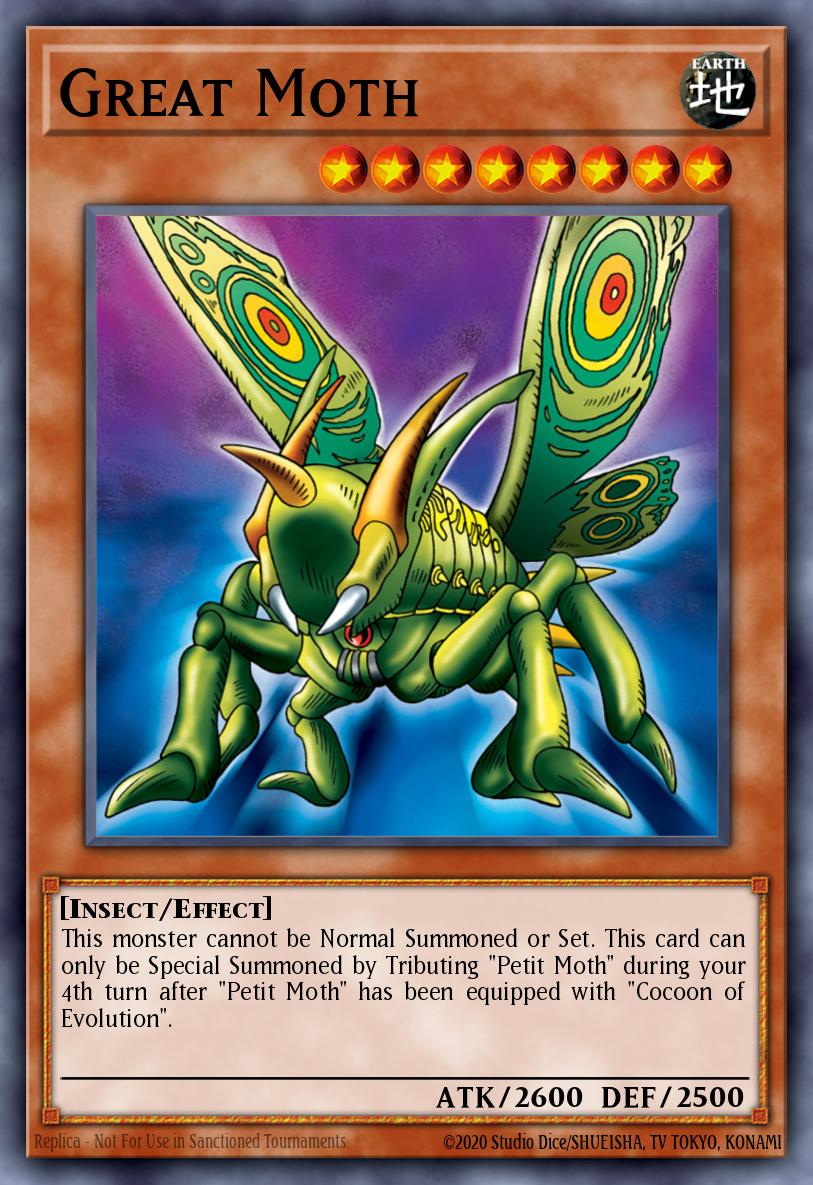 Great Moth
Great MothSuper Rares
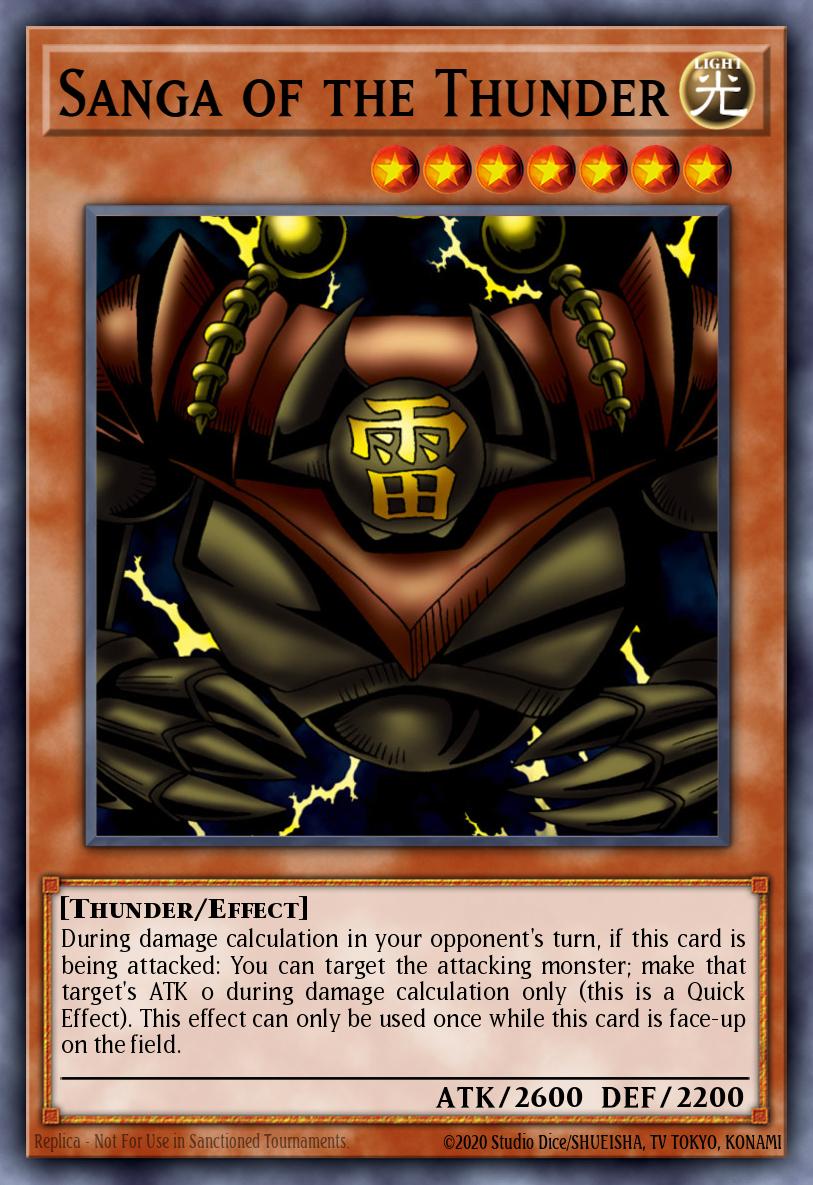 Sanga of the Thunder
Sanga of the ThunderMetal Raiders included 10 Super Rares, 8 of which are Monsters and 2 of which are Spells. The first set of Super Rare Monsters are the 3 pieces of Gate Guardian: Kazejin, Suijin, and Sanga of the Thunder. All of these monsters are level 7 and share the effect of being able to drop an opponent’s monster that is attacking them to 0 ATK once while they are face-up on the field. While this effect, combined with their relatively high ATK points, did cause them to see some casual usage at the time, their status as 2 tribute monsters made them never really catch on competitively. This is due to the difficulty decks had at the time with getting multiple monsters onto the field to make tribute summons. Because of this, they became largely relegated to casual use.
The next two Super Rare monsters are both non-Effect monsters: Garnecia Elefantis and Twin-Headed Thunder Dragon. Garnecia Elefantis never gained much notoriety as it is a strictly worse version of Dark Magician. It also has no real collector’s value as it wasn’t prominently featured in the anime. Twin-Headed Thunder Dragon was also relatively little used, being a non-Effect Fusion monster that is too high level to reasonably summon off of Magical Scientist or Metamorphosis. Due to their combined lack of collector value and usability, neither of these cards has ever held much value and they are likely to stay at their low value going forward.
The next Super Rare monster is Harpie Lady Sisters, a card that has never seen any competitive play. Although technically usable in Harpie Lady decks that came out much later, the combination of being difficult to summon while also having no notable effect and a level that doesn’t match the other Harpie Lady monsters has prevented the card from ever catching on. It does still hold some value, however, as a collector card due to its prominent usage by Mai Valentine in the first season of the anime.
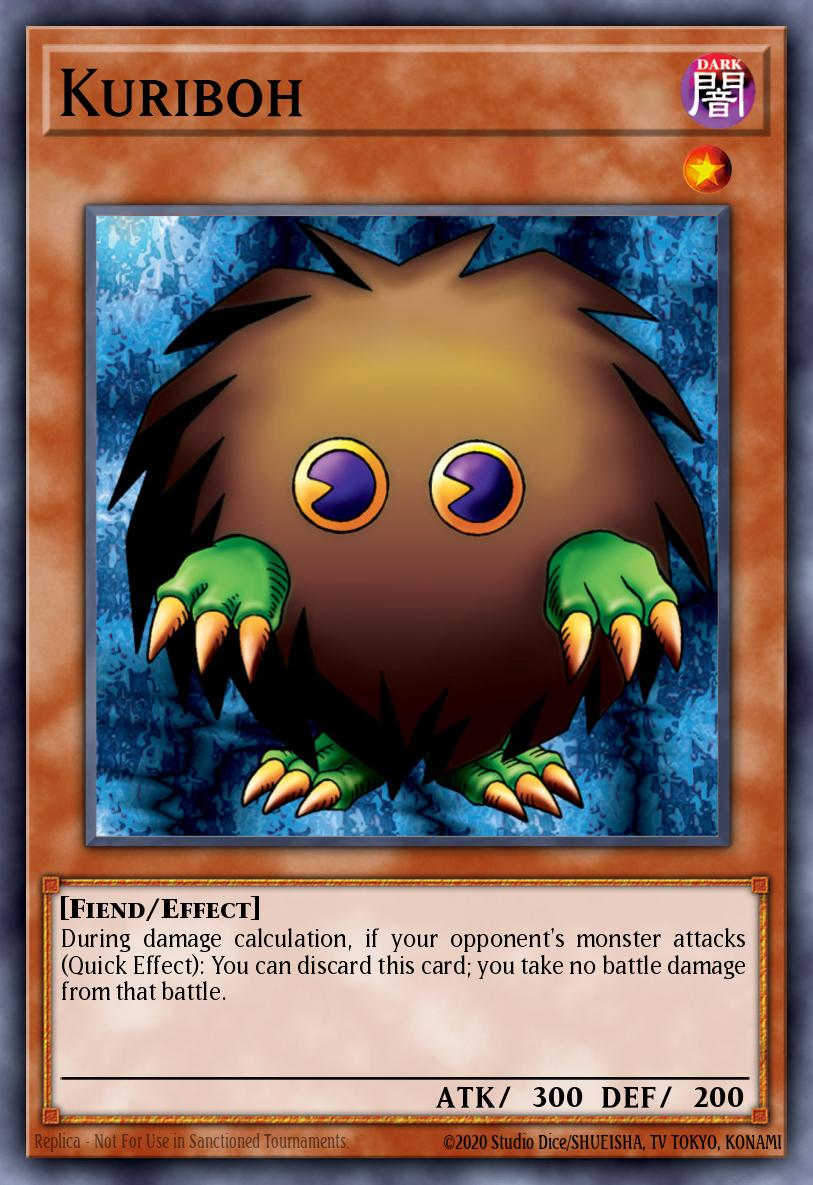 Kuriboh
KuribohThe last two Super Rare monsters were both used in season one of the anime by Yugi and saw some minor competitive usage: Kuriboh and Catapult Turtle. Kuriboh saw the greater usage of the two, experiencing a life as a somewhat popular side deck and main deck tech choice during the Chaos formats of 2004-2005. This was largely due to Kuriboh’s ability to both prevent damage from an opponent’s monster and serve as fodder for the summoning of a Chaos monster once in the Graveyard. Catapult Turtle, although less popular than Kuriboh, found its way into the meta through the Magical Scientist deck. The card was essential to pulling off the OTK using Magical Scientist as it had one of the strongest burn abilities available at the time. This burn ability was predicated on a nearly unlimited supply of high ATK monsters however, making Catapult Turtle’s usage drop off after the Forbidding of Magical Scientist in early 2005. Due to both card’s prominence in the early anime they have both received multiple reprints which, combined with their lack of relevancy in the modern meta, has caused them not to retain much value.
The final two Super Rare cards in Metal Raiders are both Spell Cards: Heavy Storm and Tribute to the Doomed. Heavy Storm is by far the more prominent of the two. It holds the distinction of being the first form of mass Spell and Trap removal in the game as well as the first generic Spell/Trap removal (all previous cards only effected either Spells or Traps, not both). As such, it checked the power of various Trap Cards that would spring up over the next several sets. It was also Semi-Limited and then soon after Limited due to its staple status. It would go on to eventually be Forbidden briefly in 2010 and then moved back to Limited a year later, finally settling once again at Forbidden in 2013, a status that it still holds today. Its high potential usefulness should it ever once again be made legal to play has kept its value slightly higher than most of the other more low value Super Rares in the set. It also still sees use in legacy formats such as Goat Format. It is because of this Legacy usage and future potential that Heavy Storm has managed to still retain the highest value of any Super Rare in Metal Raiders.
The final Super Rare card released in Metal Raiders is Tribute to the Doomed. This card saw relatively widespread usage in 2002 as it held the unique status of being the first Spell card that offered targeted destruction. Tribute to the Doomed’s cost, although causing a technical loss in card advantage, was less of a negative at this early stage in the game due to the slower pace of the game and overall lower quality of available cards meaning that often a relatively useless card could be used as discard fodder for its effect. The card would see a drop off in usage as more useful staple Spells and Traps became available, making Tribute to the Doomed less necessary.
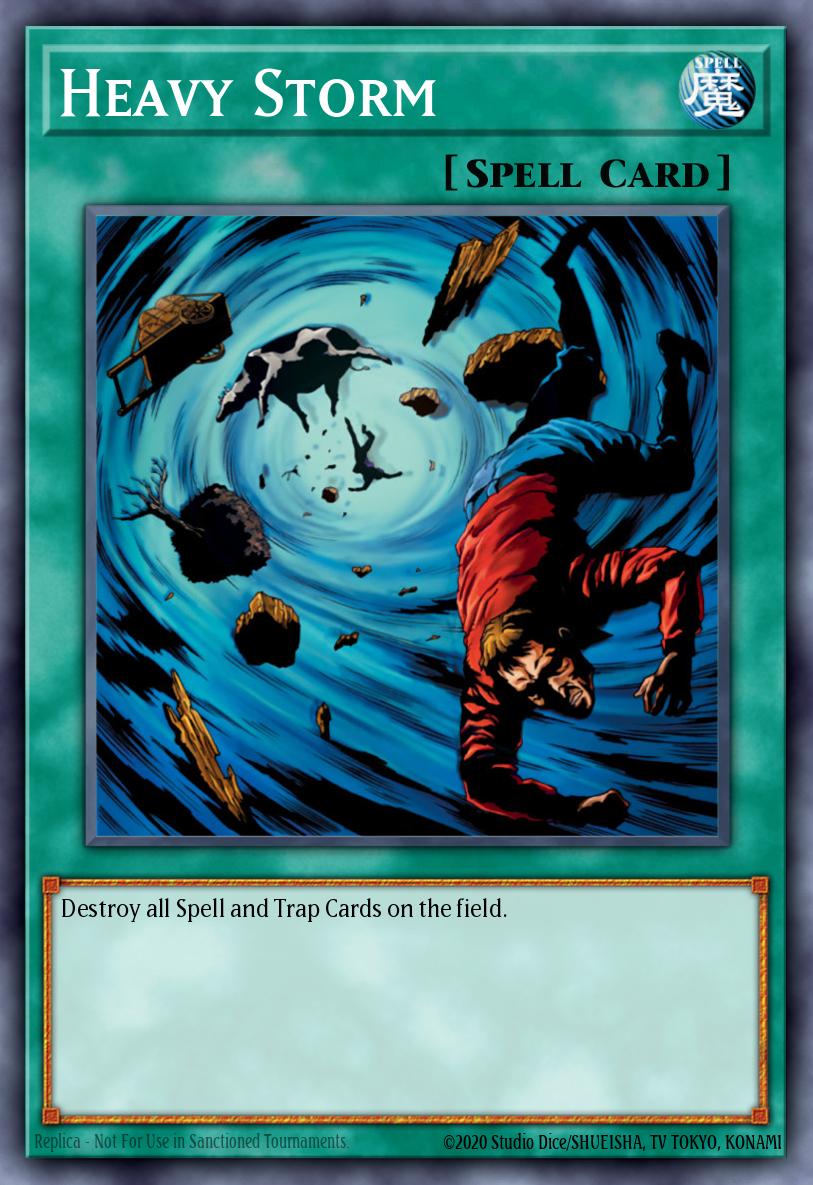 Heavy Storm
Heavy StormUltra Rares
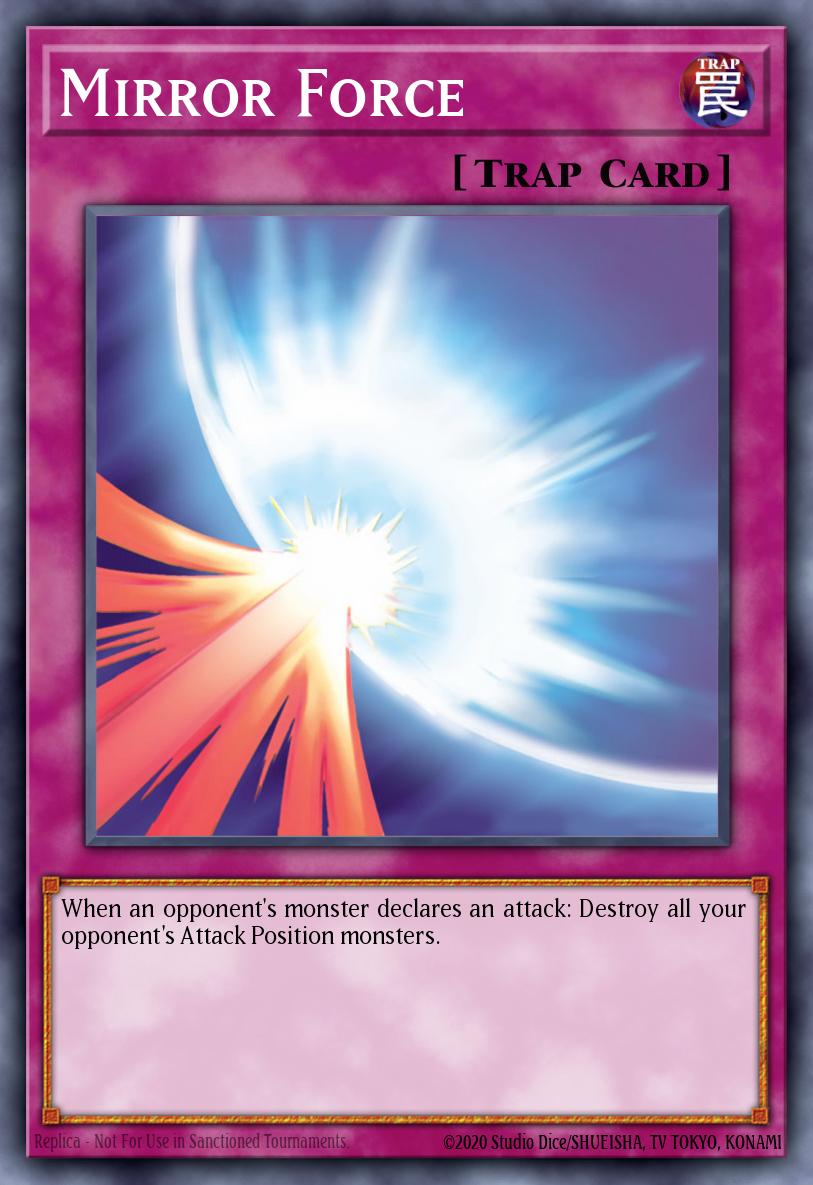 Mirror Force
Mirror ForceMetal Raiders included 10 Ultra Rares consisting of 5 Traps, 4 Monsters, and a Spell. The first of these 5 Traps is easily one of the most notable cards in the whole set: Mirror Force. Upon its release, Mirror Force instantly became a staple in every deck as it was the most powerful Trap Card available at the time. While more powerful Traps would eventually be released, Mirror Force maintained its position as one of the best Traps, even being considered so powerful that it was Forbidden on the very first Forbidden and Limited List. This wouldn’t last long as the card would soon be moved back to Limited status where it would stay for many years until it eventually moved back up to being Unlimited. Although Mirror Force is not as all-powerful as it was upon release, the card still finds a place in modern formats against monsters that are vulnerable to destruction effects. Because of this and its usefulness in Goat Format, the Metal Raiders printing of Mirror Force has held a relatively high value compared to most other cards in the set.
The other 4 Ultra Rare Trap Cards released in Metal Raiders were all a new subtype of Trap released in Metal Raiders: Counter Traps. The thing that made Counter Traps unique compared to Normal and Continuous Trap Cards is that they could only be responded to by other Counter Trap Cards. Because of this, the effects chosen for these initial Counter Traps were all effects that negated different types of cards. First there was Horn of Heaven which negated the Summon of a monster at the cost of its controller tributing a monster they control. Because this card ended in a net loss in card advantage, it never saw much usage until the advent of monsters that could generate further advantage upon hitting the Graveyard. The most prominent deck to utilize this card as a tech choice was Burning Abyss, but it never caught on as an essential card for the deck. The next Counter Trap was Magic Jammer. This card negated a Spell Card at the cost of discarding one card. While Magic Jammer also ended up causing a loss in card advantage, in the early game especially it was much more worthwhile due to the availability of extremely powerful Spell Cards that would potentially net the opponent large amounts of card advantage. This made the slight loss in card advantage worthwhile as it caused a greater loss in potential card advantage that the opponent would have gained had they successfully resolved their Spell.
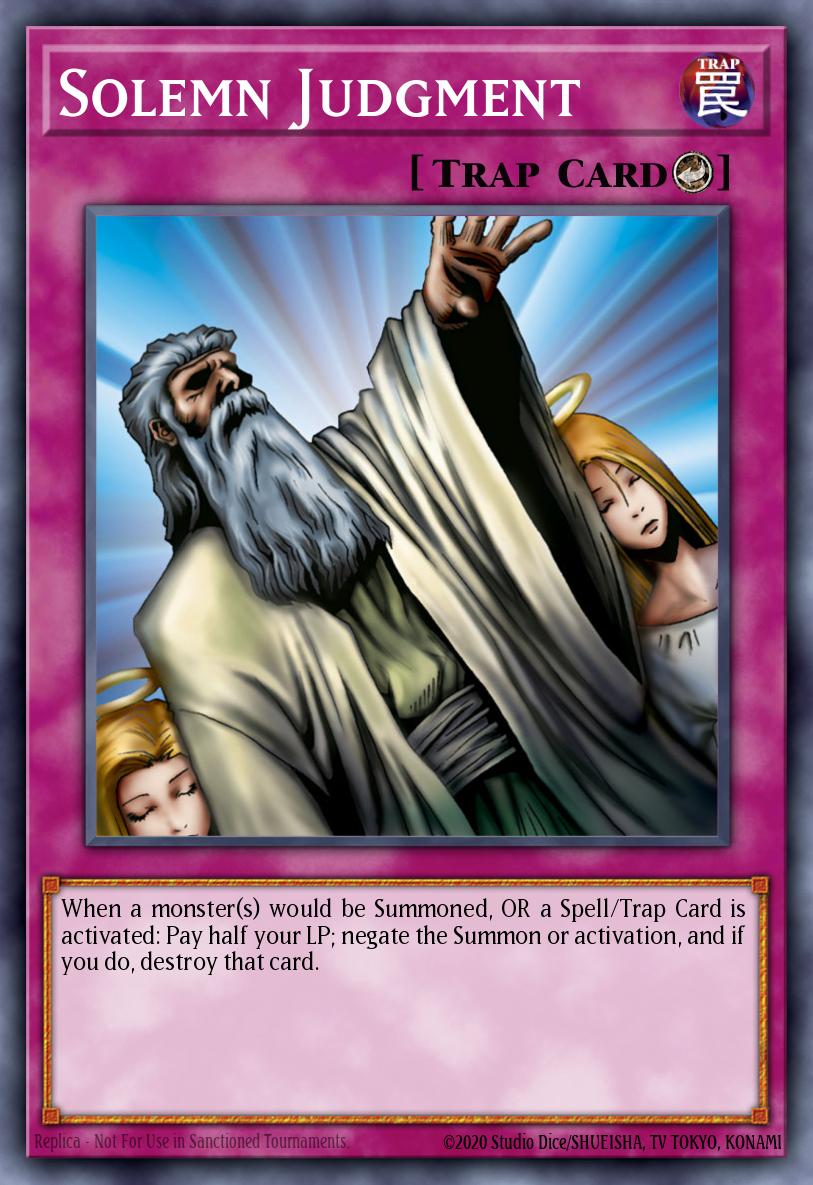 Solemn Judgment
Solemn JudgmentNext was Seven Tools of the Bandit which negated a Trap at the cost of 1000 Life Points. This Counter Trap had the mildest cost, causing it to see some play for its ability to negate the powerful Trap Cards that were prevalent in the early game such as Mirror Force and Imperial Order. Finally, there was Solemn Judgment which could negate a Spell, Trap, or Summon at the cost of half of its controller’s Life Points. While this was seemingly too steep of a cost for many players, it did see some play in certain combo based decks that couldn’t afford to get their combo disrupted. The card would become a staple later on as more and more powerful monsters entered the meta game such as Gladiator Beast Gyzarus and Dark Armed Dragon. The sheer power of these monsters and their potential to destroy an opponent in one turn made the loss of Life Points worthwhile to prevent their summoning. Because of this rise in prevalence, Solemn Judgment would go on to become Limited and ultimately Forbidden some years later. In spite of this, the card has managed to hold relatively high value in the Metal Raiders printing, primarily due to how essential of a staple it was for so long.
The next two Ultra Rare cards were both very influential cards upon their release, but did not receive their original printings in Metal Raiders. These two cards are Summoned Skull and Change of Heart. Both of these cards were first released in Starter Deck Yugi several months earlier, meaning that their printings in Metal Raiders weren’t as in demand. Despite the easier availability of their Common printings in the Starter Deck, both of these cards have managed to hold some value largely due to their collectibility. Summoned Skull in particular holds one of the highest values of cards printed in Metal Raiders due to its prominent role in the anime as one of Yugi’s major cards.
The next two Ultra Rare monsters were both used in the first season of the anime by Joey Wheeler: Time Wizard and B. Skull Dragon. While neither of these ever saw any competitive play, Time Wizard served as Joey’s signature card throughout much of the anime and B. Skull Dragon was the cover card for the Metal Raiders set. This has caused them to retain a decent collectible value, with B. Skull Dragon being one of the highest value cards in the set in its 1st Edition printing.
The last Ultra Rare card released in Metal Raiders is Barrel Dragon. Although it never saw much highly competitive play, its high ATK and potential ability to wipe out an opponent’s board with its effect made the card gain traction and see relatively frequent use at the locals level throughout 2002 and 2003. This was before more powerful effect monsters made most two tribute monsters like Barrel Dragon no longer worth the loss in field presence needed to summon them. Because of this fall from relevance and not being as sought after for collection purposes as cards used by main characters, Barrel Dragon has retained a relatively low value amongst the Ultra Rares in the set.
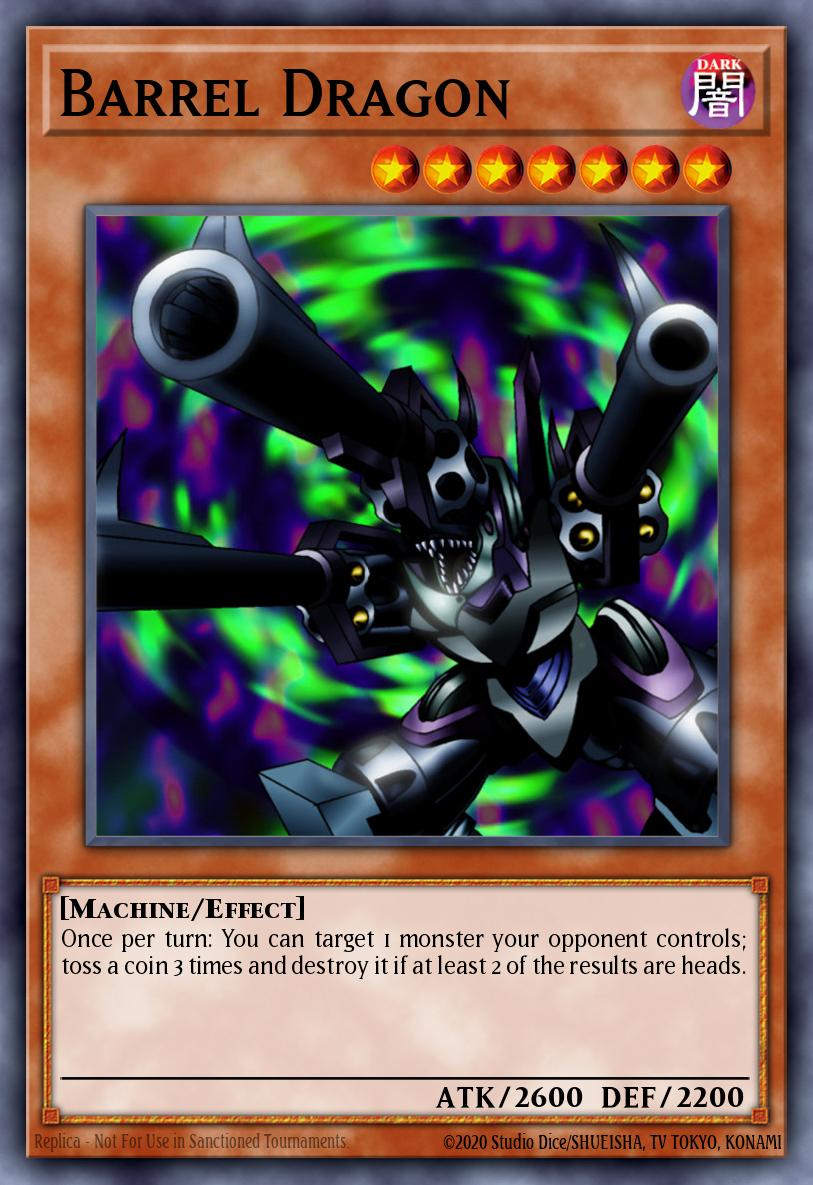 Barrel Dragon
Barrel DragonSecret Rares
Metal Raiders included 2 Secret Rare cards, both of which are Monsters. Much like Legend of Blue-Eyes White Dragon, the Secret Rares in Metal Raiders never saw any real use. The first of these is Thousand Dragon, a non-Effect Fusion Monster with relatively low ATK. Due to its level, it wasn’t easily summonable off of Magical Scientist or Metamorphosis, so it ended up being strictly a collector’s item much like Gaia the Dragon Champion. The other Secret Rare is Gate Guardian. Although a very powerful monster, Gate Guardian never saw play due to its extremely difficult summoning condition. It requires that Kazejin, Suijin, and Sanga the Thunder all be on the field simultaneously while Gate Guardian itself is in the hand. Due to their high levels, this was extremely difficult to pull off and ultimately resulted in a monster with no actual effects. Because of this summoning condition and lack of searchability, Gate Guardian has been relegated to the same status as Great Moth of a monster that is too difficult to ever practically summon. In spite of this, Gate Guardian has retained a very high value because of both its low supply and high collectibility as a significant card from the anime.
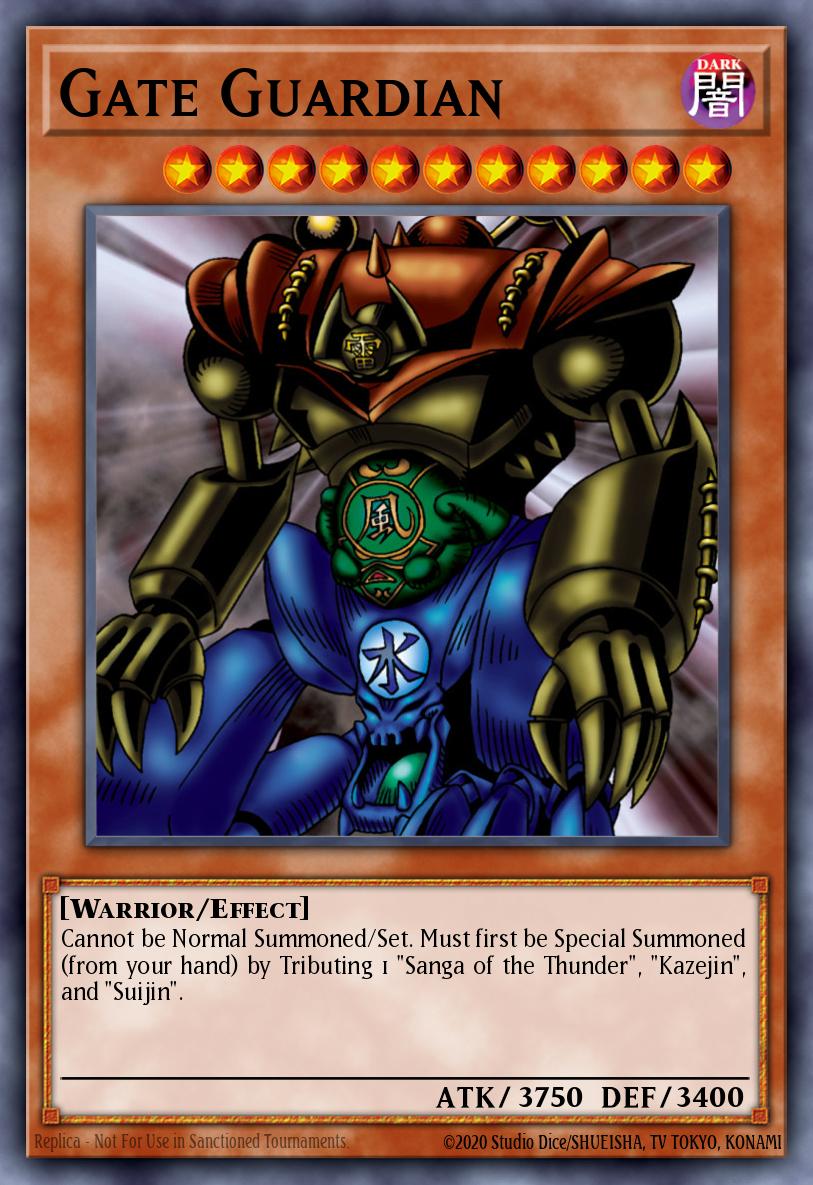 Gate Guardian
Gate GuardianHidden Potential
Because Metal Raiders was a very early set, many of the cards in it have not retained their values throughout the years for a variety of reasons. The first reason is the high number of printings that the set released, creating a relatively large supply of Unlimited versions of the cards. A lot of the cards in the set have also been power creeped by newer cards while the only ones that haven’t have almost all been reprinted multiple times in relatively accessible reprint sets. Because of these factors, the main value cards are the Ultra Rares, which, although they have all seen numerous reprints and aren’t very prevalent in the modern game, have largely held their value as collector’s items. The most notable of these Ultra Rares are Mirror Force, Solemn Judgment, and Summoned Skull. Mirror Force has held its value due to its continued ability to played in the competitive meta. However, it has seen greatly varied usage depending on how resistant decks in a given format are to standard destruction effects. This has made it so that the price of Mirror Force goes up and down depending on the current meta. Solemn Judgment maintains value largely as a collector’s card and for people who play legacy formats, but the value of it would most certainly skyrocket if the card was moved out of the Forbidden section of the Forbidden and Limited List. While there is no indication of this happening, the OCG Forbidden and Limited List as of their July 2017 List has the card at Limited and has had it at that status for several years.
Summoned Skull and by extension several other cards in this set all hold value largely as collector’s items. What this means is that their price in the market is largely unaffected by reprints as they are valued for their specific rarity and printing more than the card itself. These cards also rely on being in good condition and in a 1st edition printing as well to achieve maximum value. The cards with the most potential in this area are largely the Super Rare and Ultra Rare cards used in the anime. The final card with a hidden potential for value is Heavy Storm. Although currently Forbidden and unlikely to be made legal again anytime soon, its price still has a chance to jump due to the continued popularity of legacy formats like Goat Format causing demand from the card and often in high rarity or original printing.
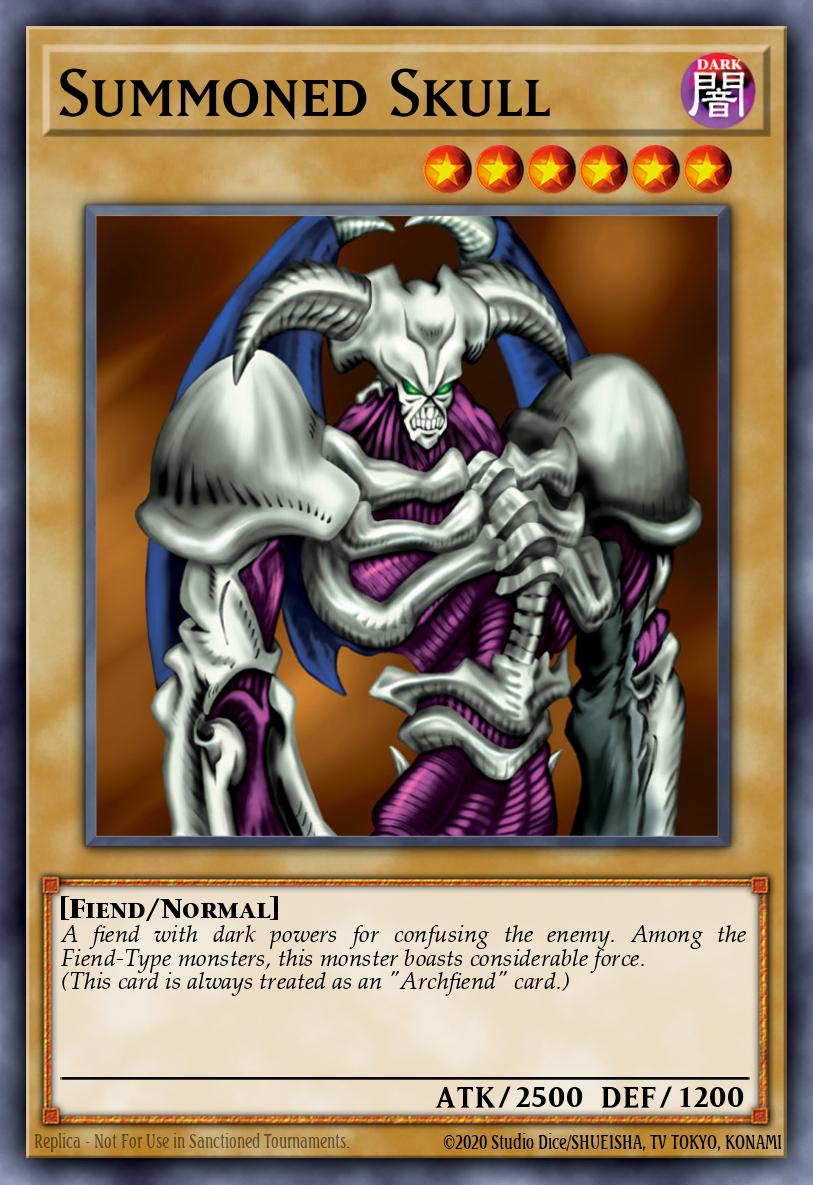 Summoned Skull
Summoned SkullImpact on the Game
Although Metal Raiders was the third major product release in the TCG for Yu-Gi-Oh!, it had one of the biggest impacts on the game in the long term. It not only introduced a large number of more playable Effect Monsters, but also introduced a large number of cards that would be staples for months or years after the set’s release. Perhaps the most significant impact of Metal Raiders was that the cards it introduced allowed for a greater variance in deck building as well as adding more strategic depth to the game. This would pave the way for tournaments becoming less of a competition between Starter Decks with slight modifications and more towards the modern game. Overall, while it didn’t truly start anything in the TCG, Metal Raiders played an extremely important role in pushing the game forward into being a fully fledged trading card game that would be able to stand the test of time.




